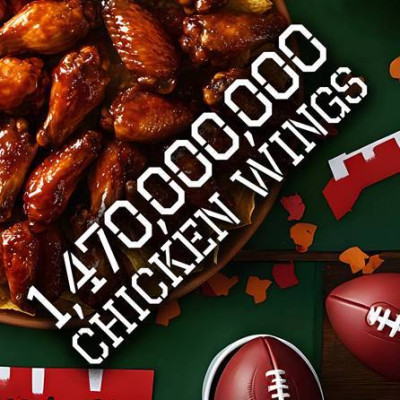Chicken – the meat everyone loves
 From chicken tikka masala to game-day wings, chicken is a crowd-pleaser that unites fans and families around the table.
From chicken tikka masala to game-day wings, chicken is a crowd-pleaser that unites fans and families around the table.
We all know that chicken is good for you, but let’s be honest – not everything good for us is popular. Chicken, however, is the exception. It’s the most widely consumed meat in the world, loved across cultures for being versatile, affordable, and, most importantly, delicious!
And the numbers prove it. According to the Royal Society of Open Science, chicken consumption is growing faster than any other type of meat. Every year, about 50 billion chickens are eaten worldwide—an incredible 137 million per day. Over the past century, chicken has overtaken beef and pork as the world’s favorite meat, and that trend is only set to continue.
A recent report from the Organisation for Economic Co-operation and Development (OECD) and the United Nations Food and Agriculture Organization (FAO) predicts that global chicken consumption will accelerate even further in the coming decade.
As a leading provider of quality breeder chicks, Aviagen® is proud to support poultry farmers worldwide in keeping chicken sustainable, accessible, and ready to meet growing demand.
The US can’t get enough of chicken – especially the wings
The United States leads the world in chicken consumption, with 21.19 million metric tons eaten annually. From crispy wings to hearty soups, chicken is a staple in American kitchens. According to recent reports, chicken restaurants are outperforming the rest of the dining sector. Fried chicken chains, specifically, saw visits grow 4.3%, while similar quick-service and fast-casual chains saw 1.3% and 2.4% growth (source).
 One of the biggest chicken feasts happens every year on Super Bowl Sunday, and Americans are set to devour an estimated 1.47 billion chicken wings, as reported by Meatingplace.com (up from 1.45 billion last year). According to the National Chicken Council (NCC), this marks a 1.5% increase from last year, equating to about 4.5 wings for every American. The NCC offered a fun analogy: 1.47 billion wings would be enough to circle the Earth three times or fill every seat in all 30 NFL stadiums with 693 wings each.
One of the biggest chicken feasts happens every year on Super Bowl Sunday, and Americans are set to devour an estimated 1.47 billion chicken wings, as reported by Meatingplace.com (up from 1.45 billion last year). According to the National Chicken Council (NCC), this marks a 1.5% increase from last year, equating to about 4.5 wings for every American. The NCC offered a fun analogy: 1.47 billion wings would be enough to circle the Earth three times or fill every seat in all 30 NFL stadiums with 693 wings each.
The love for wings goes way back. As the Buffalo History Museum records, the famous Buffalo wing originated in Buffalo, New York, when a bar owner tossed leftover wings in a peppery hot sauce for her son and his friends. After rave reviews, the wings hit the menu the next day and quickly became a hit.
It’s not just wings that keep demand high. The chicken sandwich wars, which kicked off in 2019, saw fast-food chains battle for the title of best fried chicken sandwich, fueling even greater consumer demand for crispy, flavorful chicken options.
A global phenomenon

The US isn’t the only country with a serious appetite for chicken. China and Brazil follow closely behind, consuming 15.1 and 14.9 million metric tons per year, respectively (source).
In China, chicken is a key ingredient in traditional dishes like Hainanese chicken, kung pao, and beggar’s chicken. The country’s love for chicken is also linked to health perceptions—many people see it as a leaner, healthier option.
Meanwhile, in Europe, chicken consumption has nearly doubled since 1990. According to a 2024 report, Europeans now eat an average of 25.04 kg per person per year (source). While no single European country matches the US or China in total consumption, together, the continent consumes a comparable amount of chicken.
The UK’s love for chicken is evident in its booming fried chicken market, with chains like KFC, Wingstop and Popeyes expanding rapidly (source).
In Africa, chicken has been a staple for thousands of years, with its introduction dating back to 2,500 BC in Egypt. Today, it remains one of the most widely consumed proteins across the continent, valued for its affordability, accessibility, and ability to take on bold flavors. Whether it’s Nigerian chicken stew, Ghanaian grilled chicken, or South Africa’s Braai drumsticks, chicken is at the heart of many beloved dishes (source).
In the Middle East, where dining out is an integral part of the culture, chicken reigns as the most popular protein on restaurant menus. From fragrant shawarma wraps and juicy grilled kebabs to slow-cooked stews, chicken plays a starring role in traditional and modern cuisine alike. Its popularity is driven by its versatility, as well as its acceptance across different dietary preferences.
The rise in global chicken consumption is also evident in the expansion of chicken-centric restaurant chains worldwide. Many of these focus on familiar, delivery-friendly options like tenders, which younger people tend to prefer because they’re easier to handle, and fried chicken meals (source).
Why is chicken so popular?
So what makes chicken the world’s go-to protein?
It is affordable and accessible. Chicken is budget-friendly and widely available.
There are no cultural barriers. Chicken is consumed across almost every culture and religion.
It is healthy and nutritious. It’s lean, packed with protein, and fits into nearly every diet.
It provides endless variety. Whether grilled, roasted, fried, or curried, chicken adapts to countless cuisines.
From Indian chicken tikka masala to Italian herb-roasted chicken, Thai curry skewers, and French coq au vin, chicken brings people together through food. No matter where you are in the world, chances are, there’s a delicious chicken dish waiting for you. And of course, on Super Bowl Sunday, chicken wins as the ultimate game-day snack that unites fans everywhere.
